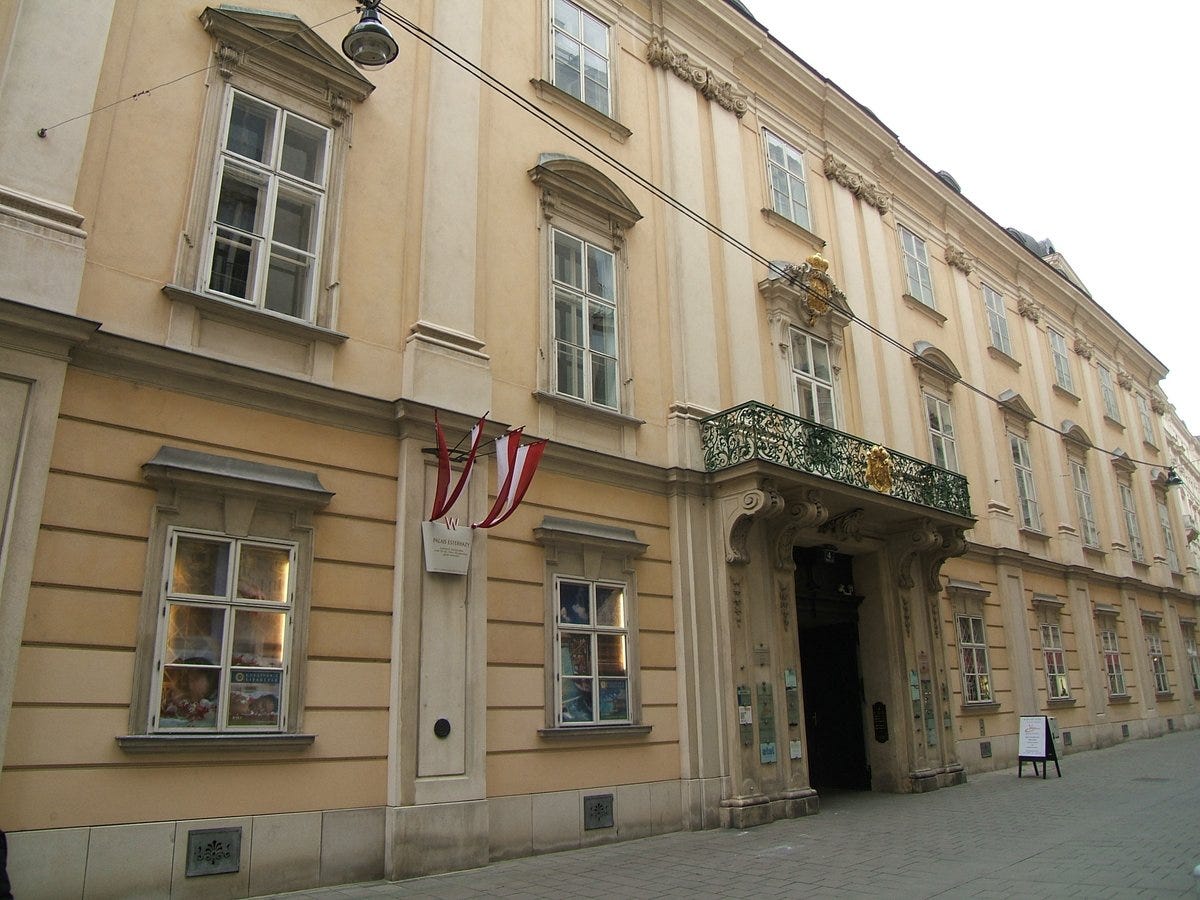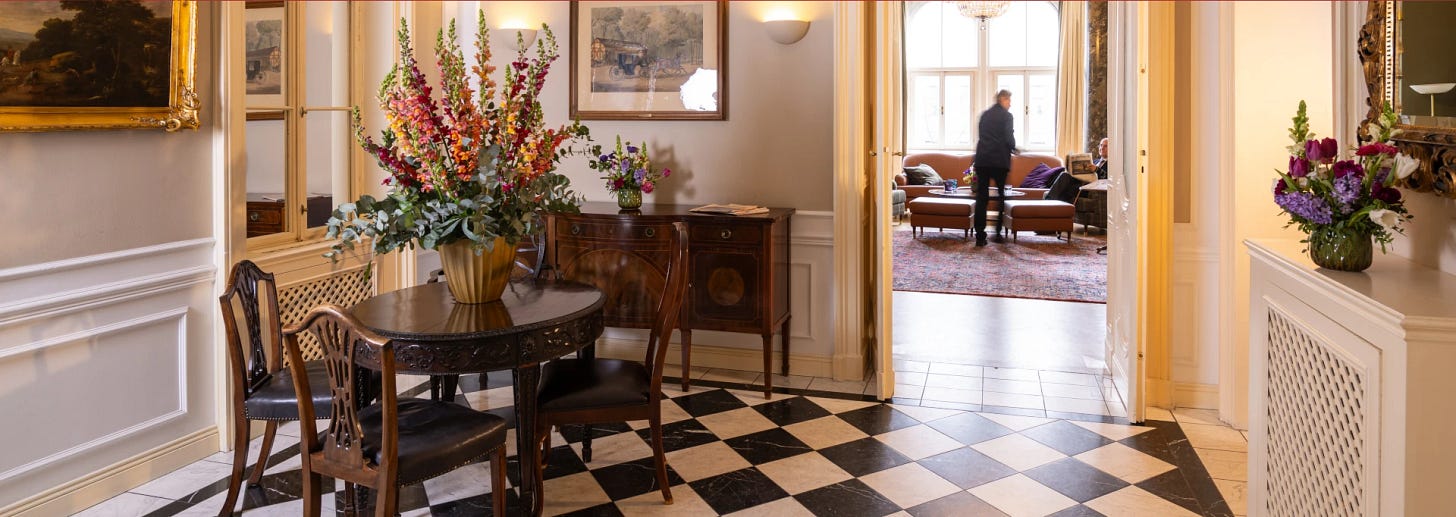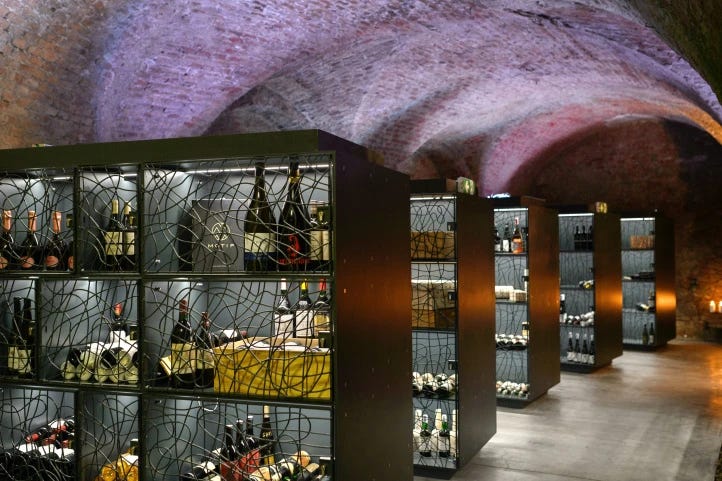The clubs of Vienna. (Base map: Google Maps.)
Vienna has been settled since at least the first century AD, and was already a major European capital as the seat of the Habsburgs from the 13th century; but much of central Vienna today was moulded by the massive expansion and reconstruction of the city during the 68-year reign of Emperor Franz Joseph I: encircled by the Ringstrasse, the city centre became one of Europe’s great imperial capitals, with construction only completed in 1913. The creation of Austria-Hungary from 1868-1918 saw Viennese society adjust - and create its own brand of ‘clubbable’ society, often heavily focused around equestrianism.
The Jockey Club of Vienna. (Photo credit: Real Club de Andalucia “El Aero” website.)
Most of Vienna’s historic clubs are in the equestrian tradition. The city is synonymous with its Spanish Riding School dating back to the 16th century teaching classical dressage. The oldest of the clubs is the Jockey Club, founded in 1868, and still numbering just a few hundred members. This is very much the equivalent of the Turf Clubs of London and Lisbon, and the Jockey Club of Paris, being an overwhelmingly aristocratic gentlemen’s club for racehorse owners and those preoccupied with racing. The Club’s forebear was the Vienna Racing Committee formed in 1826 to organise horse racing, and which evolved in 1854 into the Vienna Horse Racing Society. In 1868, after further mergers with other aristocratic clubs, it was reconstituted as a club.
For many years, the Jockey Club maintained historic premises in the Philipphof, and it maintained the fiction that it had been dissolved to avoid attention from the Nazis after the Anschluss, while continuing to discreetly meet during the war years - until it was bombed out with a direct hit on 12 March 1945. In the post-war years, it has been based on the Schubertring, while it also rebuilt its historic racecourse at Freudenau. The Club does not have bedrooms, but has an arrangement with the nearby Hotel Sacher.
Another club-like organisation dating from the Austro-Hungarian period is the Österreichische Campagnereiter-Gesellschaft (Austrian Campaign Rider Association). This was founded in 1872, organising its first dressage contest in Bratislava the following year, and in Vienna since the year after that. The Jockey Club was from the beginning a corporate member, with heavy overlap between the organisations. Today it has evolved away from a traditional club, yet still maintains a headquarters in the Hofburg, and much of its club life is found through the equestrian events it organises around Vienna.
The Palais Esterházy, which has housed the Wiener Rennverein since 2023. (Photo credit: audiala.com.)
The Wiener Rennverein (Viennese Racing Association) is a gentlemenm’s club formed in 1932 by the titular pretender 10th Prince Kinsky of Wchinitz and Tettau, with a charter committing it to the promotion of breeding Austrian thoroughbreds, and the organising of races on Jockey Club rules. It originally leased rooms in the Hotel Bristo at 6 Mahler Street, but was compulsorily seized by the Nazi Ministry of Agriculture in Berlin after the 1938 Anschluss, since its members’ main occupations were around farming or horsebreeding. The members meanwhile discreetly continued to meet through the Jockey Club in the Philipphof until the end of the war. After the Philipphof’s bombing, the Club took temporary lodgings in the Stiegengasse for a year.
From 1946, the Wiener Rennverein was based in the 18th century Palais Pallavicini - a familiar building to film buffs, as it features prominently in The Third Man (1949) as Harry Lime’s apartment block. However, a long-running dispute with the landlord culminated in the Club moving to new premises in 2023, relocating to a wing of the Palais Esterházy, with portions dating back to the 17th century.
Its membership numbers some 300, with a low threshold for blackballing - a candidate’s proposer or seconder must be the incumbent President or Vice-President, and membership candidates are put to a ballot of the entire membership; just two members voting against a candidate are enough to veto an application.
The St. Johanns Club. (Photo credit: St. Johanns Club website.)
The post-war reconstruction of Viennese club life saw the creation of a new gentlemen’s club in 1954, the St Johanns Club. It saw itself as an unofficial successor to the Vereinigung katholischer Edelleute in Österreich (Association of Catholic Noblemen in Austria) which had been banned by the Nazis in 1938; and the new club came under the patronage of the Order of Malta (which is reflected in its logo, the Maltese cross). However, this criteria is not a strict one for membership of the Club, with around one-third of its approximately 750 members being non-aristocrats. The Club lodges with the Jockey Club, sharing their building.
The Vienna branch of wineBANK. (Photo credit: wineBANK website.)
A much more recent club is wineBANK Wien. This is part of a wider chain of some 16 wine-themed clubs in Germany, first established in 2009, and which opened the Viennese branch in 2016, as one of only two branches outside of Germany (the other being in Washington D.C.). The clubs, located either in big cities or in vineyard regions, have a heavy degree of automation, and offer their members wines by the bottle or by the glass, as well as on-site private storage of their own bottles. The Vienna branch has approximately 2,000 members. Unlike Vienna’s earlier clubs, it is mixed-sex.
The rooftop terrace of Am Hof 8. (Photo credit: TO Interior Design website.)
Vienna’s most recent club is another mixed-sex club, Am Hof 8, which opened in 2022 on the historic piazza. The brainchild of Johannes Kattus, whose family has owned the 16th century building since 1857, the Club claims its inspiration from English clubs. Kattus’ 19th century namesake ancestor opened the premises as a “trader in delicacies”, vending wine, coffee, tea, spirits, caviar and tropical fruits - which are reflected in decor that emphasises global trade. As well as more traditional club facilities, the clubhouse also offers its members a workspace, roof terrace, basement nightclub, and uniquely for a Viennese club, bedrooms - it has five.
You can view the full and varied backlog of Clubland Substack articles, by clicking on the index below.
Index
Articles are centred around several distinct strands, so the below contains links to the main pieces, sorted by theme.









